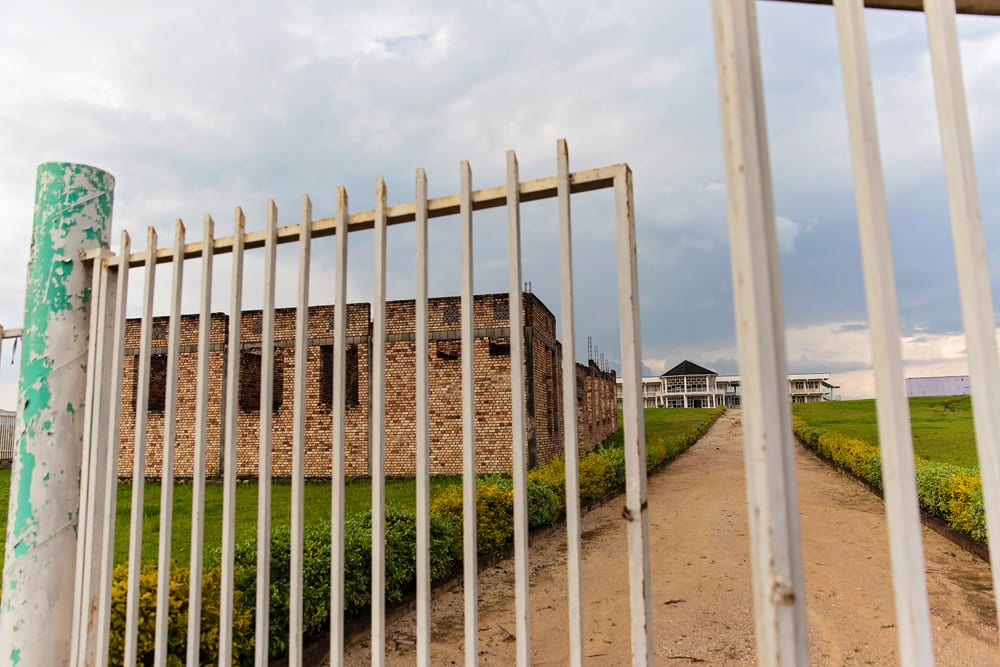 As I wrote in my first Rwanda post, you can’t come here without confronting the country’s bloody history. In order to better educate the world about what happened here, memorials have been established at the sites of important genocide locations. Kigali, Ntarama, Nyamata, Kibuye, and Nyamagabe are some of the key sites, and we have now visited Nyamata, Kigali, and Nyamagabe.
As I wrote in my first Rwanda post, you can’t come here without confronting the country’s bloody history. In order to better educate the world about what happened here, memorials have been established at the sites of important genocide locations. Kigali, Ntarama, Nyamata, Kibuye, and Nyamagabe are some of the key sites, and we have now visited Nyamata, Kigali, and Nyamagabe.
The Kigali Genocide Memorial is currently under construction, so we were only able to visit the display about the Rwandan genocide, and not the exhibits about genocide in a global context or how Rwanda has moved forward after the atrocities visited upon its Tutsi and moderate Hutu population. The memorial is impactful, poignant, peaceful, and full of a symbolism and hope, all of which woud be in stark contrast to what we would experience later that afternoon in Nyamagabe.
There is a series of large concrete “tanks”, for lack of a better word, outside the main building, which serve as mass graves for the 250,000 Rwandans who were murdered in Kigali alone; this memorial has become the final resting place for the bodies that have been found, and those that will be found as construction on the city’s hills progresses and more graves are found. Surrounding the tanks, though, are a series of gardens, which would probably be quite spectacular during the dry season because of the amount of flora – roses, vines, and a multitude of other flowering plants. As it was, it still made for a peaceful end of the tour and a good way to spend some quiet time reflecting on everything we’d just learned.
I’ve been to a number of museums and memorials related to genocide, including Birkenau, Aushwitz, Cambodia’s Killing Fields, Mostar and Sarajevo, but nothing prepared me for what we were about to see in Nyamagabe. Fleeing Tutsi were led to believe that this technical college would be a safe haven from the attacking Interahamwe. They were lied to. 50,000 innocents were led to this hilltop location (genius – it meant the militia could see them at all times) where they were starved for a number of days before, ultimately, being massacred over a period of 7 hours.
Displays inside the museum explain the history of the massacre and, in no uncertain terms, lay blame for the country’s fate at the feet of the international community, who had multiple opportunities to stop the government forces, but didn’t. Most notable points: France enabled the government to expand its army by providing training to the Interahamwe and securing the purchase of 12 MILLION dollars of arms from Egypt, that were then given to government armies; the number of forces used to evacuate the expat community would have been enough to bring the war to an end BEFORE the genocide really got into full force; the French army stood by or, in some cases actively assisted the government’s mission by participating in anti-Tutsi demonstrations or allowing Interahamwe soldiers safe passage out of the country; the quotation from survivor, Apollon Kabahizi, “When they said ‘Never again’ after the Holocaust, was this meant for some people and not for others?” I cant help but think that, were I a French backpacker, it would be impossible to leave here without being filled with shame on behalf of my government. As it was, I was embarassed by the failings of the West.
Our guide, Eric, was a man of very few words, but he led us to a series of outbuildings (former classrooms), where the preserved bodies of 1000 victims are laid out on tables. The thought of their remains, skin bleached white from the lime, still brings tears to my eyes as I flick back through the mental pictures of adults holding infants; of stomachs stretched from forced famine, now slack and misshapen from decay; of the distorted positioning of limbs – whether because of how the victim died or because of how they fell into the pit when they were buried is irrelevant: either answer indicates the complete dehumanisation of an entire race.
Eric, 13 when the genocide occured, lost his parents and all four siblings. When I asked about how he managed to survive, he declined to explain, but the small extracts of his story that he did share made it clear that, just because you survived one attack, didn’t mean you’d survived the war. The heart of the genocide lasted 100 days and Tutsis were under attack every single day – just because you escaped once, didn’t mean you weren’t going to have to escape again and again and again…. They truly were a hunted race.
The Nyamagabe memorial is the first time we’ve ever seen traces of bitterness showing through the pervasive sense hope so prevalent in this country – and justifiably so. In the courtyard between two buildings, there’s a sign indicating where the French flag stood during Operation Turquoise, when the French, who were supposed to be securing the country, provided safe passage to Interahamwe soldiers in the aftermath of the genocide so that they could flee the country and avoid prosecution. Further along, past the buildings and looking out on a spectacular vista of the surrounding hills, are four more signs indicating the locations of mass graves. The French used the surface of one of the graves (conveniently, it’s perfectly level) as a volleyball court, with full knowledge of what was under their feet. Day after day, Eric has to tell the story of how a country lost families, innocence, and faith in the international community. It’s clear that he doesn’t want to divulge on a personal level, but performs his duties at the memorial for the sake of national unity and global education.
Nyamagabe wreaks of loss and speaks of horror. The ghostly ivory building on its hilltop perch; the isolation of the site; the starkness of the complex; the accusatory statements on the informative posters inside; the inescapable evidence of the bodies, preserved for the sake of education.
We walked down the path away from the building, which sat on its own under heavy clouds, and felt haunted by the horrors contained within. Despite the fact that I have very few photos to remind me of my walk through the museum, I doubt I will ever forget what we saw.
Grateful for: cultural freedom; survivors willing to make these memorials happen







